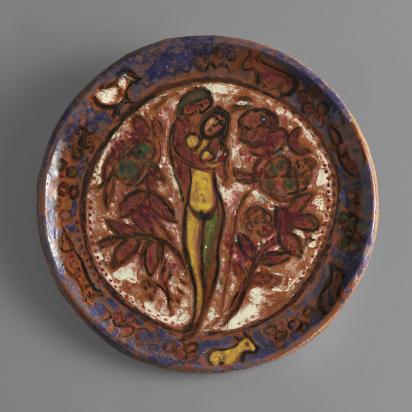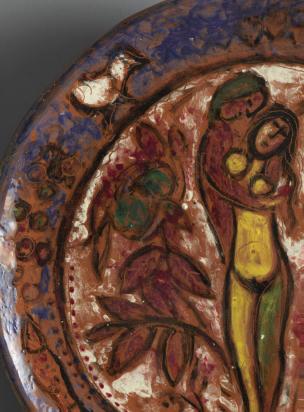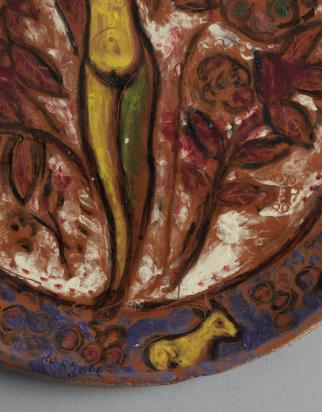Exhibited just once, at the Palais des Beaux-Arts in Brussels in 1957, the Persian Plate falls outside the major thematic series transposed into ceramics by Chagall in the early 1950s, such as La Fontaine's Fables and the Bible. As his command of ceramics technique improved, Chagall continued to push back the boundaries of technical and iconographic experimentation. Produced in red chamotte clay, the Persian Plate combines the artist's personal vocabulary, Mediterranean motifs and a free interpretation of Persian pottery, famous for its technical and decorative virtuosity.
The decoration demonstrates Chagall's rich visual culture mixed with freedom of interpretation. Iridescent color glazes, created by light reflected by metal particles in suspension, luster enamels, which appeared in Iraq as early as the ninth century before spreading to Persia and Syria, are one of the most striking innovations of Islamic pottery. Chagall's use of dark red engobes, left in reserve, imitates the copper-based luster widely used by Persian potters. This type of decoration, with its coppery luster and large figures, could be compared to the Persian "monumental style " practiced in the last quarter of the 13th century. Chagall moved away from the main feature of this tradition, which consists in drawing the figures and decorative elements in reserve.
Inspired by Egyptian pottery techniques, notably frits , combined with the influence of Chinese porcelain imported on a massive scale during the pre-Mongol period, Persia asserted its taste for color. Glazes were tinted blue, turquoise, green and violet—all colors found on the Persian Plate. The rim features Chagall’s bestiary, evoking the circular frieze of animals on some pieces in the Kashan-style.
Chagall's appropriation of Oriental motifs was part of a wider movement begun by Western artists and craftsmen in the 19th century that continued into the 20th. Henri Matisse wrote about his own attraction to the Orient: "Revelation has always come to me from the East. In Munich, I found further confirmation of my research. Persian miniatures, for example, showed me the full potential of my sensations. Through its accessories, this art suggests a larger space, a true visual space.” Édouard Cazaux's Persian-inspired ceramics of the 1920s and 1930s feature traditional animal motifs and decorative elements. Chagall's Persian Plate, his only explicit foray into the world of Oriental pottery, pays tribute to the intrinsic, qualities of the time-honored practice of ceramics, a refined combination of mutual influences, styles and the sharing of craftsmanship.





